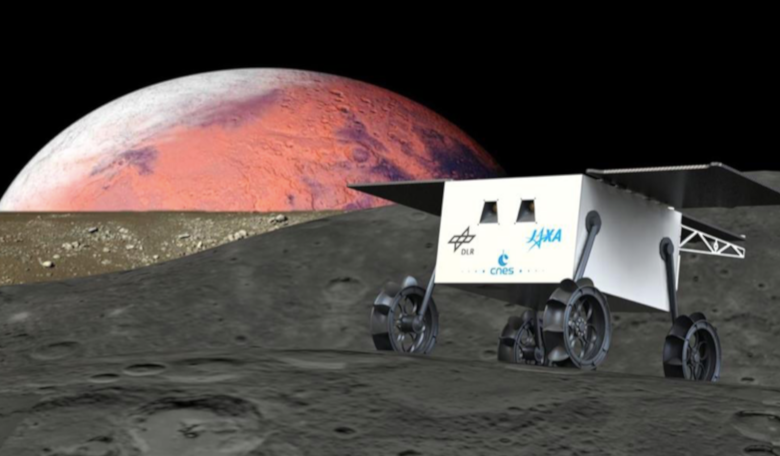With the Moon and Mars firmly in everyone’s sight as potential targets for up and coming interplanetary missions, the Japanese Space agency want to do things a little differently. Instead of touching down on either of our nearest celestial neighbours, JAXA, along with help from German Aerospace Center (DLR), are planning to collect surface material with a German-French rover from one of Mars’ moons – Phobos and Deimos – and then bring it back to Earth for analysis.
Currently under development and scheduled for launch around 2024, the MMX (Martian Moons eXploration), is, as the title suggests, a mission to explore Mar’s moons.
At present, there are two dominant theories to explain where Phobos and Deimos, two of the smallest moons in the solar system, came from. Some scientists suggest that the lumpy, heavily-cratered asteroid-like objects were already floating out in space and were subsequently captured after the formation of Mars. Others suspect the moons were once part of Mars’ itself and accumulated from material that was ejected from the Red Planet after a giant impactor crashed into it sending chunks of rock into orbit.
Whichever the scenario, MMX is on a mission to find out what the true answer is. Aside from a thorough observation of Mars and its moons system, the mission will also serve as a testbed to improve sampling techniques on other celestial bodies and to try out communication technologies between the spacecraft and a newly developed ground station.
MMX will achieve its mission objectives by entering a quasi-stationary orbit (QSO) around Mar’s moons and performing various observations as it circles overhead. A stay of around 3 years is planned for the spacecraft, and once observations and sample collection has taken place, MMX will then make the year long journey back to Earth to drop off its rocky martian cargo sometime in 2029.
While preparations for developing a spacecraft are currently underway, JAXA is busy collaborating with European counterparts on making the world’s first exploration of a minor Solar System body with a rover a reality.
"The world-first exploration of the Martian moons with a rover is a major technical challenge that we are tackling within the framework of our strong and proven partnership with Japan and France," says Pascale Ehrenfreund, Chair of the DLR Executive Board. "Together, we want to push the boundaries of what is technically feasible in robotic exploration and expand our knowledge about the origin of the Solar System."
After conducting studies of the rover, both DLR and the French space agency CNES will then build the vehicle as a joint effort. DLR will be responsible for providing a spectrometer and a radiometer that will both be used to determine the characteristics and composition of the surface, along with developing the rover’s casing and its robotic locomotion system. CNES on the other hand is making major contributions with camera systems for spatial orientation and exploration of the surface, as well as the rover’s central service module.
CNES and DLR, will then be jointly operate the rover once it is safely ensconced on the Martian moon surface.
JAXA is no stranger to sending spacecraft to other-world bodies to examine them up close. As part of their Hayabusa2 mission, which is currently exploring the asteroid Ryugu, the agency’s Mobile Asteroid and Surface Scout (MASCOT) lander ‘hopped’ across the asteroid’s surface and sent spectacular images of a landscape strewn with boulders and stones back to Earth; a feat that the agency will be hoping to emulate with its MMX mission.











